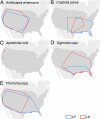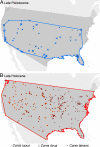Niche conservatism above the species level
- PMID: 19897730
- PMCID: PMC2780937
- DOI: 10.1073/pnas.0901648106
Niche conservatism above the species level
Abstract
Traits that enable species to persist in ecological environments are often maintained over time, a phenomenon known as niche conservatism. Here we argue that ecological niches function at levels above species, notably at the level of genus for mammals, and that niche conservatism is also evident above the species level. Using the proxy of geographic range size, we explore changes in the realized niche of North American mammalian genera and families across the major climatic transition represented by the last glacial-interglacial transition. We calculate the mean and variance of range size for extant mammalian genera and families, rank them by range size, and estimate the change in range size and rank during the late Pleistocene and late Holocene. We demonstrate that range size at the genus and family levels was surprisingly constant over this period despite range shifts and extinctions of species within the clades. We suggest that underlying controls on niche conservatism may be different at these higher taxonomic levels than at the species level. Niche conservatism at higher levels seems primarily controlled by intrinsic life history traits, whereas niche conservatism at the species level may reflect underlying environmental controls. These results highlight the critical importance of conserving the biodiversity of mammals at the genus level and of maintaining an adequate species pool within genera.
Conflict of interest statement
The authors declare no conflict of interest.
Figures




References
-
- Ceballos G, Ehrlich P, Soberon J, Salazar I. Global mammal conservation: What must we manage? Science. 2005;309:603–607. - PubMed
-
- Graham R, et al. Spatial response of mammals to late Quaternary environmental fluctuations. Science. 1996;272:1601–1606. - PubMed
-
- Lyons S. A quantitative assessment of the range shifts of Pleistocene mammals. J Mamm. 2003;84:385–402.
-
- Root T, et al. Fingerprints of global warming on wild animals and plants. Nature. 2003;421:57–60. - PubMed
MeSH terms
LinkOut - more resources
Full Text Sources

